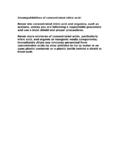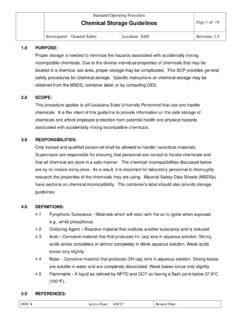Transcription of BROMINE 6011 See CHLORINE, Method 6011, for procedure
1 BROMINE 6011 See CHLORINE, Method 6011, for procedure Br2MW: : 7726-95-6 RTECS: EF9100000 Method : 6011, Issue 2 EVALUATION: FULLI ssue 1: 15 May 1989 Issue 2: 15 August 1994 OSHA ppm; STEL ppm; STEL ppm(1 ppm = mg/m3)PROPERTIES:liquid; d g/mL @ 20 C;BP C; VP kPa (175 mm Hg)@ 20 C vapor density (air=1) :PREFILTER + FILTER(PTFE, m + silver membrane,25-mm, m)FLOW to 1 L/minVOL-MIN: 8 L @ ppm-MAX:360 LSHIPMENT:routine, protect from lightSAMPLE STABILITY: 30 days at 25 C [1]BLANKS:2 to 10 field blanks per setMEASUREMENTTECHNIQUE:ION CHROMATOGRAPHY, CONDUCTIVITYANALYTE:bromide ion (Br-)EXTRACTION:3 mL 6 mM Na2S203, 10 min INJECTION VOLUME:50 LCOLUMN:Dionex HPIC-AG4A guard, HPIC-AS4 Aseparator, MFC-1 precolumn, AMMS anion suppressorDETECTOR SETTING.
2 10 S full mM NaHCO3/4 mMNa2CO3 mM p-cyanophenol, 2 mL/minCALIBRATION:standard solutions of Br- indeionized waterRANGE:5 to 150 g Br- per sample [1]ESTIMATED g Br- per sample [1]PRECISION (S r) @ 5 to 100 g per sample [1]ACCURACYRANGE to mg/m3(72-L samples)BIAS:- PRECISION (S rT) [1]ACCURACY: : The working ranges for Br2 and Cl2 are to ppm ( to mg/m3) and to ppm ( mg/m3) respectively for a 90-L air sample. The Method has sufficient sensitivity for STEL : hydrogen sulfide gives a negative interference.
3 HCl gives a positive interference upon a maximum of 15 gper sample. HBr gives a positive interference as it is sampled continuously [1].OTHER METHODS: P&CAM 209 (colorimetric) [2], OSHA Methods ID-101 [3] and ID-108 [4] are alternative Manual of Analytical Methods (NMAM), Fourth Edition, 8/15/94 CHLORINE 6011 Cl2MW: : 7782-50-5 RTECS: FO2100000 Method : 6011, Issue 2 EVALUATION: FULLI ssue 1: 15 May 1989 Issue 2: 15 August 1994 OSHA :C 1 ppm; STEL 1 ppm; STEL 1 ppm(1 ppm = mg/m3 @ NTP)PROPERTIES:gas; d g/L at 0 C; BP C.
4 Vapor density (air = 1) :PREFILTER + FILTER(PTFE, m + silver membrane,25-mm, m)FLOW to 1 L/minVOL-MIN: 2 L @ ppm-MAX:90 LSHIPMENT:routine, protect from lightSAMPLE STABILITY: 30 days at 25 C [1]BLANKS:2 to 10 field blanks per setMEASUREMENTTECHNIQUE:ION CHROMATOGRAPHY, CONDUCTIVITYANALYTE:chloride ion (Cl-) or bromide ion (Br-)EXTRACTION:3 mL 6 mM Na2S203, 10 min INJECTION VOLUME:50 LCOLUMN:Dionex HPIC-AG4A guard, HPIC-AS4 Aseparator MFC-1 precolumn, AMMS anionsuppressorDETECTOR SETTING:10 S full mM NaHCO3/4 mM Na2CO3 p-cyanophenol, 2 mL/minCALIBRATION:standard solutions of Cl- in deionizedwaterRANGE:2 to 50 g Cl- per sample [1]ESTIMATED g Cl- per sample [1]PRECISION (S r) @ to 100 g per sample [1]ACCURACYRANGE to mg/m3(15-L samples)BIAS:- PRECISION (S rT) [1]ACCURACY: : The working ranges for Br2 and Cl2 are to ppm ( to mg/m3) and to ppm ( mg/m3) respectively for a 90-L air sample.
5 The Method has sufficient sensitivity for STEL : hydrogen sulfide gives a negative interference. HCl gives a positive interference up to a maximum of 15 g per sample. HBr gives a positive interference as it is sampled continuously [1].OTHER METHODS: P&CAM 209 (colorimetric) [2], OSHA Methods ID-101 [3] and ID-108 [4] are alternative Manual of Analytical Methods (NMAM), Fourth Edition, 8/15/94 CHLORINE AND BROMINE : Method 6011, Issue 2, dated 15 August 1994 - Page 2 of 5 thiosulfate, reagent , solution: 6 mM Na2S2O3. g Na2S2O3 in 500 mL deionized : mM NaHCO3/4 mMNa2CO3 mM p-cyanophenol.
6 G NaHCO3, g Na2CO3 g p-cyanophenol in 2 L filtereddeionized regenerant, N H2SO4. Dilute mL conc. H2SO4 to 4 L withdeionized water.* stock solutions, 1 mg/mL (asanion).(1)Dissolve g KBr in 100 mLdeionized water(2)Dissolve g KCl in 100 mL deionizedwater.*See SPECIAL : : Silver membrane filter,* 25-mm, m, (Costar/Nuclepore, Poretics, orequivalent) with porous plastic support pad(Costar/Nuclepore); prefilter, PTFE with PTFE support, m (Gelman Zefluor, SKC, orequivalent), or polyester, m(Costar/Nuclepore) with porous plastic supportpad; three-piece, 25-mm carbon-filledpolypropylene cassette (opaque) with 50-mmextension (Costar/Nuclepore or Gelman)(Fig.)
7 1). the outlet piece of cassette, placeporous plastic support pad and cleanedsilver filter. Insert 50-mm extension (cowl) the inlet (top) of the extension, placeporous plastic support pad and inlet cassette piece each connection with shrinkablebands or tape. sampling pump, to 1 L/min, withflexible connecting tubing. chromatograph with Dionex MFC-1, HPIC-AG4A, HPIC-AS4A columns, AMMS anionmicromembrane suppressor, conductivitydetector and integrator (page 6011-1). , 30-mL, wide mouth with screw caps,amber or opaque polyethylene.
8 , with disposable tips. flasks, 10- and 100-mL. reagent dispensers, 0 to 10-mL. , 10-mL, polyethylene, luer-tip. *Silver membrane filters must be cleanedprior to use (see APPENDIX A).NOTE:Some lots of silver membranefilters contain excessively highchloride background screen before field PRECAUTIONS: Sulfuric acid is extremely corrosive to skin, eyes, and mucous protective clothing. Handle in a fume each personal sampling pump with a representative sampler in sampler to personal sampling pump with flexible at an accurately known flow rate between and 1 L/min for a total sample size of 8 to360 L for BROMINE or 2 to 90 L for ends of sampler with plugs.
9 Pack securely for Manual of Analytical Methods (NMAM), Fourth Edition, 8/15/94 CHLORINE AND BROMINE : Method 6011, Issue 2, dated 15 August 1994 - Page 3 of 5 SAMPLE PREPARATION:NOTE:Silver halides are photosensitive. Protect from light during transfer and very dim or red light, open cassette and transfer the silver filter with forceps to amberbottle. Add 3 mL 6 mM Na2S2O3 and :Prefilter may be analyzed for particulate halides, or samples to stand a minimum of 10 min with occasional : Once desorbed, samples are no longer the sample bottles and add 7 mL deionized water for a total solution volume of 10 sample into 10-mL plastic syringe for manual injection or into autosampler AND QUALITY daily with at least six working standards covering the range of to 15 g bromideand/or to 5 g chloride per mL of known aliquots of calibration stock solution to deionized water in 10-mL volumetricflasks and dilute to the mark with deionized fresh working standards working standards together with samples and blanks (steps 11)
10 Through 13). a calibration graph (peak height vs. g of anion per sample). three quality control spikes, three analyst spikes and media blanks to ensure thatcalibration graph is in ion chromatograph according to manufacturer's instructions and to conditions given on :Excessive amounts of Ag+ and Ag(S2O3)23- deteriorate column preformance. Use ametal free column (MFC-1) prior to the chromatographic columns and recondition thecolumn every 100 to 150 analyses (See APPENDIX B). 50- L sample aliquot manually or with autosampler. For manual operation, inject 2 to 3mL of sample from syringe to ensure complete rinse of the sample peak height.















